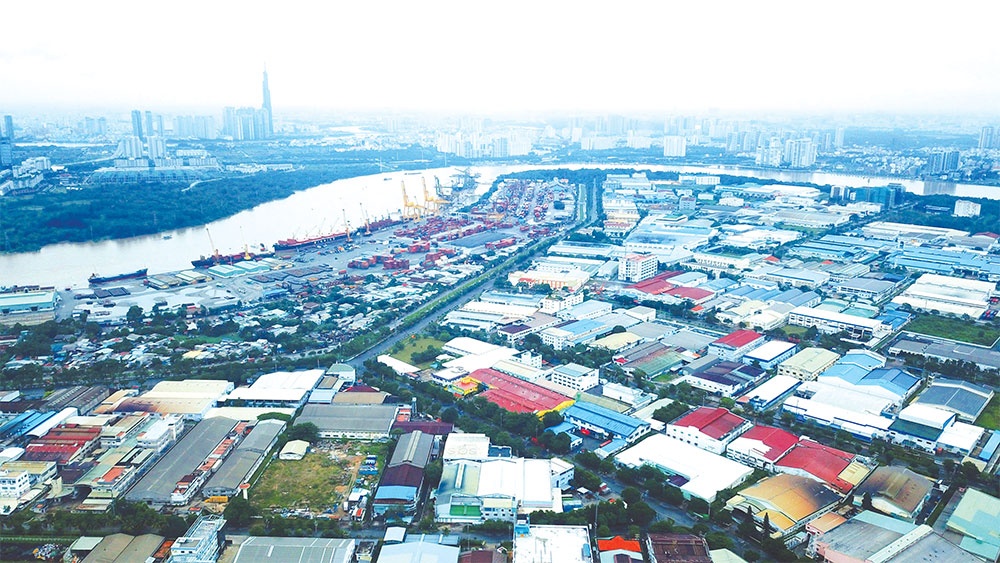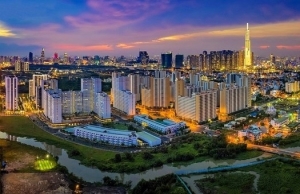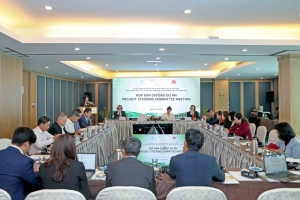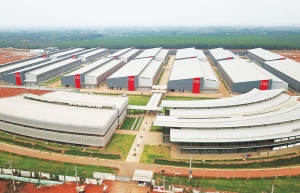Vietnam taking stock of industrial park capacities
 |
| Space is running out at some industrial parks and even Ho Chi Minh City is looking to approve more, photo Le Toan |
A May 2 dispatch from the government has requested localities to review and evaluate the occupancy rate of industrial parks (IPs), clusters, economic zones, and high-tech zones, as well as the rate of land use for production and business purposes.
The dispatch was also sent to various relevant ministries as well as people’s committees nationwide.
It was issued in the context that a number of localities have requested adjustment of land use planning targets to 2030 and proposed adjustment of land use plan targets to 2025, focusing on using land for IPs, traffic, energy projects, and high-tech zones, among others.
Bac Giang People’s Council decided to approve draft planning for three IPs – Chau Minh/Bac Ly/Huong Lam IP (CBH), Yen Lu IP expansion, and Quang Chau 2 IP. The three IPs cover nearly 550 hectares in Hiep Hoa, Yen Dung, and Viet Yen districts, which are planned as multi-sector parks with modern infrastructure and technical systems.
The CBH park will attract businesses in forestry, food processing, mechanics, electronic components, packaging, and auxiliary industries with modern and environmentally friendly technology. The expanded Yen Lu and Quang Chau 2 will be developed into multi-sector, high-tech parks.
Meanwhile, in late April, Ho Chi Minh City sought approval of two additional IPs in the city’s IP planning, Pham Van Hai I and Pham Van II, which are also expected to welcome high-tech ventures.
The city has waited for the approval of the two IPs for a long time. Hua Quoc Hung, head of Ho Chi Minh City Export Processing and Industrial Zones Management Authority, said, “The city has had no new IP in a long time, meanwhile the occupancy ratio of existing IPs is considerable.”
In the 2010-2015 period, Ho Chi Minh City was the leader in terms of land for IPs, Hung said. “However, available land has narrowed since. At present, the total area for rent in existing IPs is approximately 300ha only,” he added.
Le Thi Bich Loan, deputy head of the Saigon High-tech Park, said, “Many large investors from the EU, the United States, South Korea, and suppliers of Intel want to invest in our park but we can’t meet their demand. For example, Samsung had plans to hire 100ha but we have had to refuse due to lack of land.”
Bac Giang faces a similar situation. The northern province currently has four IPs at full occupancy. Two others are now completing infrastructure construction. It has also established clusters to beckon more investment.
Hong Sun, chairman of the Korea Chamber of Business in Vietnam, said, “We highly appreciate the government’s effort in improving the investment environment. The global economy currently shows signs of recovery and the government’s policies are promoting efficiency. Thus, we believe that the foreign-invested capital inflow in Vietnam will bounce back very soon.”
For example, LG Display and LG Innotek have plans to expand their operations in Vietnam. LG is increasing its research and development activity in terms of electronic vehicles via establishing a new centre in Danang, Sun added.
 | Vietnamese real estate remain attractive to foreign investors The Vietnamese real estate market has remained attractive to foreign investors and investment funds despite difficulties countering domestic firms, according to insiders. |
 | Vietnam to promote eco-industrial parks with international partners The Steering Committee on the Development of Eco-industrial Parks in Vietnam, organised a meeting yesterday to discuss last year's results and set a course for the following two years of the scheme. |
 | Nation must scoop up benefits of high-tech industrial parks Although being a preferred site for major foreign investment, Vietnam’s high-tech industrial parks nevertheless face infrastructural, planning, and regulatory constraints. VIR’s Quynh Trang spoke with David Jackson, CEO of Colliers Vietnam, about the issues at hand. |
 | Private sector urged to enter eco-IP arena Authorities have been urged to foster participation of the private sector to speed up the creation of eco-industrial parks, contributing to the government's green growth strategy. |
What the stars mean:
★ Poor ★ ★ Promising ★★★ Good ★★★★ Very good ★★★★★ Exceptional
Related Contents
Latest News
More News
- Sun Group breaks ground on $2 billion Van Don casino complex (December 19, 2025 | 18:14)
- Rare, beautiful, sustainable: the mark of iconic real estate (December 19, 2025 | 08:00)
- Owner-occupied housing stabilises, paving the way for new growth cycle (December 18, 2025 | 17:04)
- Unlocking urban potential of smart cities (December 18, 2025 | 16:50)
- Green finance offers 'passport' for Vietnamese construction, building materials firms (December 15, 2025 | 08:00)
- Gamuda Land commit long-term investment (December 12, 2025 | 11:49)
- HITC ties up with Evolution to develop AI and hyperscale data centres in Vietnam (December 11, 2025 | 12:09)
- Real estate deals boom via high-profile names (December 08, 2025 | 11:32)
- Industrial segment shaped by M&As (December 08, 2025 | 08:00)
- The Privé sets the benchmark for luxury real estate (December 05, 2025 | 08:28)

 Tag:
Tag:




















 Mobile Version
Mobile Version